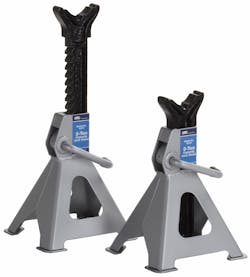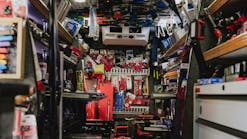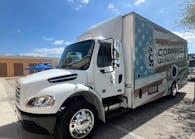Stocking lifting equipment on the truck can be tricky; it’s often too large to keep options stocked and readily available, and is generally a shop purchase.
While you may not consider offering lifting equipment that requires installation, there are a number of other product options distributors can educate themselves on to help inform customers on the right equipment for their shops.
Options such as jacks and stands, provide distributors a way to display, demonstrate and stock lifting equipment on the truck.
“While most shops will have one or more lifts, jacks and jack stands help technicians quickly service vehicles when a lift is not needed or occupied,” says Atul Patel, OTC product manager.
Product overview
Generally speaking, a jack lifts a vehicle or vehicle component; the stand is what keeps the vehicle or component in place.
“A jack should never be used solely to hold a vehicle up,” adds Patel.
Stephen Bailey, North American sales and marketing manager for SFA Companies, provides additional detail on why this is important. “There’s a rate of hydraulic deterioration that goes on immediately once lifting. Technically once you lift, it [the vehicle or component] starts coming down,” explains Bailey. “It’s fractions of an inch every hour; but it is coming down immediately after it is lifted up.”
This same idea of hydraulic deterioration applies to all types of lifting devices, including transmission jacks and engine jacks, when they do not have a mechanical locking mechanism to hold the vehicle or component.
There are different types of jacks to assist with lifting and moving large vehicle components such as engines and transmissions. “Specialty powertrain lifting jacks with lockouts are great for pulling engines or transmissions or holding them in place when installing,” says Patel.
In order to hold a vehicle or component in place once it’s lifted, techs should employ a stand to keep the vehicle raised.
Offer the proper product
Like most tools and equipment, it’s all about application.
“Before looking at features, shops and techs should ask themselves what they are trying to lift or service,” says Patel. What do you want the lifting equipment to do?
For criteria on choosing the proper jacks and stands, Bailey explains the two points shops focus on: minimum and maximum height range, and tonnage capacity, meaning “what it’s going to be able to support,” says Bailey.
For jacks specifically, in addition to the height and tonnage, shops assess their needs based on a number of criteria.
- Lifting capacity. Generally defined by how many tons a jack can lift, what’s the maximum weight allowed for using this equipment?
- Saddle size. This is the part of the jack that makes contact with the vehicle. Sizes can range from 1/2” to 8”. “How much of the saddle is touching the vehicle can provide more stability when lifting,” says Bailey.
- Pick point. The reach of the jack. How far back can the unit reach under the vehicle?
- Lifting speed. How many seconds does it take to lift the vehicle or component?
- Ground clearance. How much space is available from the floor to where the jack will make contact with the vehicle? [low-profile jacks]
- Equipment footprint. How much space does the product take up in the shop?
- Unit weight and composition. Is the jack made of heavier steel or lightweight aluminum? “A lot of people feel the heavier the jack, the shop application is better because it’s going to hold up through the course of time. Then there are other guys that use it on roadside service and stuff like that, where they want a more lightweight jack,” says Bailey.
Bailey explains that there are two types of quick-lift features available on the market: single- and dual-piston. He says SFA provides a single-piston version that allows for less moving parts. “We have three ports in the back for hydraulic block. Basically, the center port is flooded with hydraulic fluid, so that allows it so that whenever there is no contact on the jack itself, it’ll go up to load in one or two pumps,” says Bailey.
For stands specifically, consider the style of stand available: ratcheting or pin.
Bailey explains the difference between the two styles: “You have a ratchet bar with little ratchets on the side that connects with a pawl. As it goes up and down, that pawl clicks and locks into place,” he says, of the ratcheting style. “With a pin style, you can pull the pin out and it’ll freely go up and down, and not lock in place, but it has more of a sturdy locking mechanism.”
“If used on soft asphalt or in dirt, stands with a rolled base can prevent it from sinking into the ground, which can be dangerous and lead to an uneven vehicle,” says OTC’s Patel.
Bailey also explains, based on application, heavy duty shops may require a bigger body or wheels on their stands, for easier maneuverability around the shop.
There are also additional accessories that can be sold when making a jack or stand sale, depending on the application including “saddle sets, powertrain adapters for engines, transmissions, gas tanks, electric vehicle batteries and differentials will help techs lift specific components safely,” says Patel.
Safety is an important feature for any equipment used in the shop, but especially so for lifting equipment.
In 2014, ANSI PALD/PASE lifting standards were updated for portable automotive lifting devices and portable automotive service equipment to meet more stringent safety guidelines and testing procedures.
“Shop owners and techs should always look at jack and jack stand certifications. If they’re PALD and ANSI certified, you know it’s a safe lifting product that has passed minimum standards and is okay for shop use,” says Patel.
“It is a voluntary standard, but it’s the benchmark of quality in our industry,” adds Bailey.
Product trends
“There is a huge trend in imports and low-profile jacks right now, because of a need for some of the vehicles out there that are lower to the ground,” explains Bailey. “It’s not just the racecars and stuff, now it’s a lot of family and mid-sized cars are switching over to low-profile, so they (jacks) need a lower pick point.”
Aluminum jacks have also become more popular due to their lighter weight for over-the-road applications.
“There’s a trend out there with aluminum jacks because there are a lot of roadside service guys who don’t want to haul a 100-lb jack off the service truck. They want to be able to grab something 40 or 50 lbs,” says Bailey.
“As with most shop equipment, weight is a major consideration, making aluminum increasingly popular for jack construction. It’s lighter weight, easier to move around the shop or load in a vehicle for mobile service, but also comes with a higher cost,” adds Patel.
Assess your customer’s needs
When you walk into a shop, first observe and take an inventory of some of the following questions on your customer’s current equipment:
- Are they using the proper equipment for the current application?
- Where is the lifting equipment located? Is it readily available and in-use, or tucked away and forgotten?
- Do you notice any rust or damage on the current equipment?
- Are the appropriate OSHA safety labels visible?
- Is there lifting equipment, including a floor jack and jack stands, for use and readily available for each bay?
If you notice there isn’t proper equipment for each individual bay, “talk to the shop owner or talk to the technicians to provide that equipment for the individual bays. Just to limit down on time constraints with having to move the equipment back and forth,” says Bailey.
Oftentimes, there’s not enough room on the truck to stock jacks, jack stands and other relatively small lifting equipment.
“If you happen to have a jack on the truck, have it out of the box and ready for the customer to use, to show him the different features and different lifting capacities,” says Bailey.
And if you don’t stock any equipment for customers to view or test out, consider having product brochures or videos demonstrating features and functions of different equipment.
Patel explains it’s also important to understand the needs of your customers, in order to stock and demonstrate the proper equipment. Similar to a scan tool purchase, consider leaving the unit in the shop for technicians to test out in real-world applications.
“Overall, find out the needs of the shop owners on your route and stock appropriately. Displaying the wrong equipment, no matter how well it’s displayed, won’t help make the sale. If you understand your customer’s needs (i.e. a transmission shop) and you have powertrain lifts to view and demo, you’re farther ahead than if you only stocked floor or bottle jacks,” says Patel.



